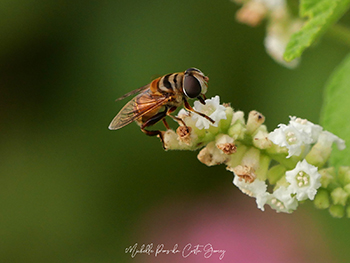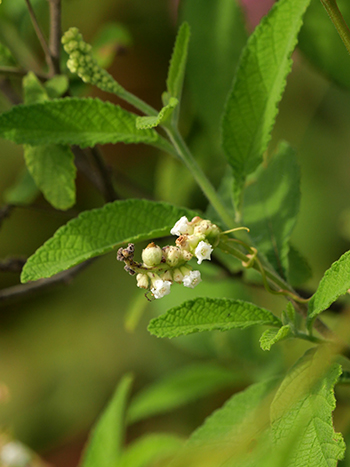
This post is also available in: Dutch (below)
The Varronia curassavica is called Basora preto on Aruba, Karishuri on Bonaire and Basora pretu on Curaçao. It is a plant that can easily be overlooked and often considered to be a weed (onkruid) and therefor erased from gardens and other locations. However it has long been used as a medicinal plant against for instance menstruation pains and other stomach and belly pains, according to information shared by the late Dinah Veeris on Curaçao. We know several people who still cleanse their house with the leaves of Basora pretu either by burning them of by crushing the aromatic leaves and brushing it over surfaces in the house.

In nature this plant is incredibly important as a food source to bees, solitary bees, wasps, hoverflies, butterflies and other insects. The flowers produce large quantities of nectar and when the plant is flowering it’s almost impossible to find it without a variety of insects on it. Such as this Palpada vinetorum, a Hoverfly species that can be found all over the island. With its colouring it shows a fantastic form of mimicry. Its colours and patterns make sure predators mistake them for bees or wasps and as such dangerous prey. All while being completely harmless.
English name: Black sage
Papiamentu/Papiamento name: Basora preto (Aruba), Basora pretu (Curaçao), Karishuri (Bonaire)
Scientific name: Varronia curassavica
Family: Boraginaceae (forget-me-not family)
Occurrence (ABC islands): Aruba, Bonaire and Curaçao

Wilde bloemen- Basora pretu (Varronia curassavica)

De Varronia curassavica wordt op Aruba Basora preto, op Bonaire Karishuri en op Curaçao Basora pretu genoemd. Het is een plant die gemakkelijk over het hoofd kan worden gezien en vaak als onkruid wordt beschouwd en daarom uit tuinen en andere locaties wordt verwijderd. Het wordt echter al lang gebruikt als medicinale plant tegen bijvoorbeeld menstruatiepijn en andere maag- en buikpijn, volgens informatie die is gedeeld door wijlen Dinah Veeris op Curaçao. Ik ken verschillende mensen die hun huis nog steeds reinigen met de bladeren van Basora pretu, hetzij door ze te verbranden of door de aromatische bladeren te pletten en over oppervlakken in huis te borstelen.

In de natuur is deze plant ontzettend belangrijk als voedselbron voor bijen, solitaire bijen, wespen, zweefvliegen, vlinders en andere insecten. De bloemen produceren grote hoeveelheden nectar en als de plant bloeit is het bijna onmogelijk om hem te vinden zonder dat er allerlei insecten op zitten. Zoals de Palpada vinetorum, een zweefvliegsoort die overal op het eiland te vinden is. Met zijn kleuren vertoont hij een fantastische vorm van mimicry. Zijn kleuren en patronen zorgen ervoor dat roofdieren hem verwarren met bijen of wespen en als zodanig een gevaarlijke prooi. En dat alles terwijl hij volkomen ongevaarlijk is.
Nederlandse naam: (?) Zwarte salie, wilde salie)
Papiamentse naam: Basora preto (Aruba), Basora pretu (Curaçao), Karishuri (Bonaire)
Wetenschappelijke naam: Varronia curassavica
Familie: Boraginaceae (ruwbladigenfamilie)
Voorkomen (ABC eilanden): Aruba, Bonaire en Curaçao